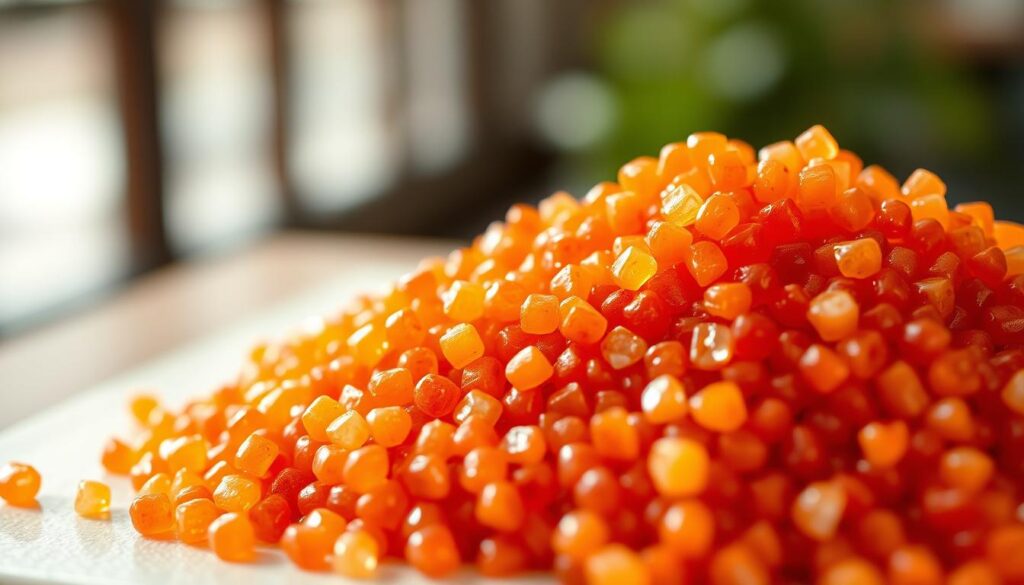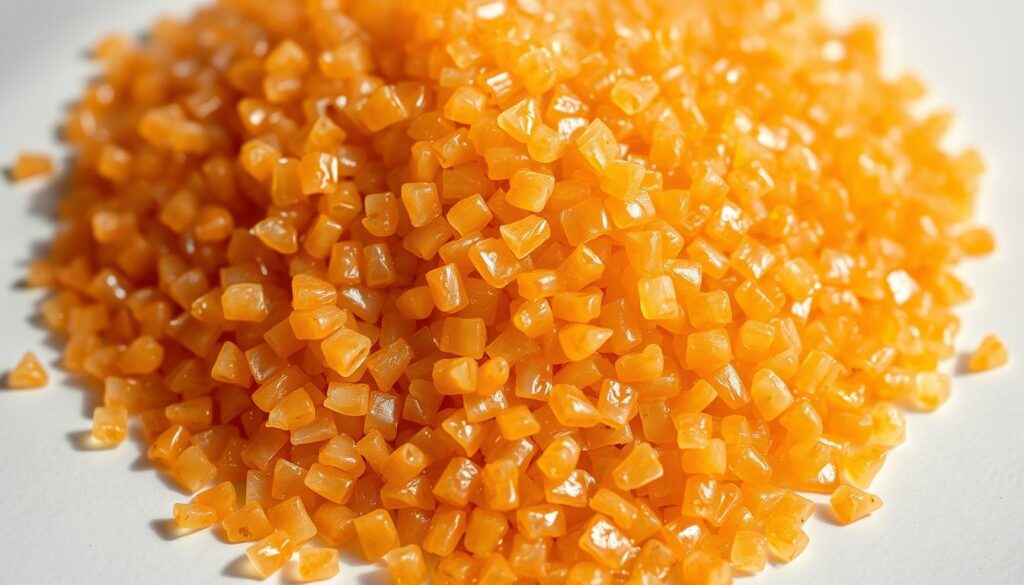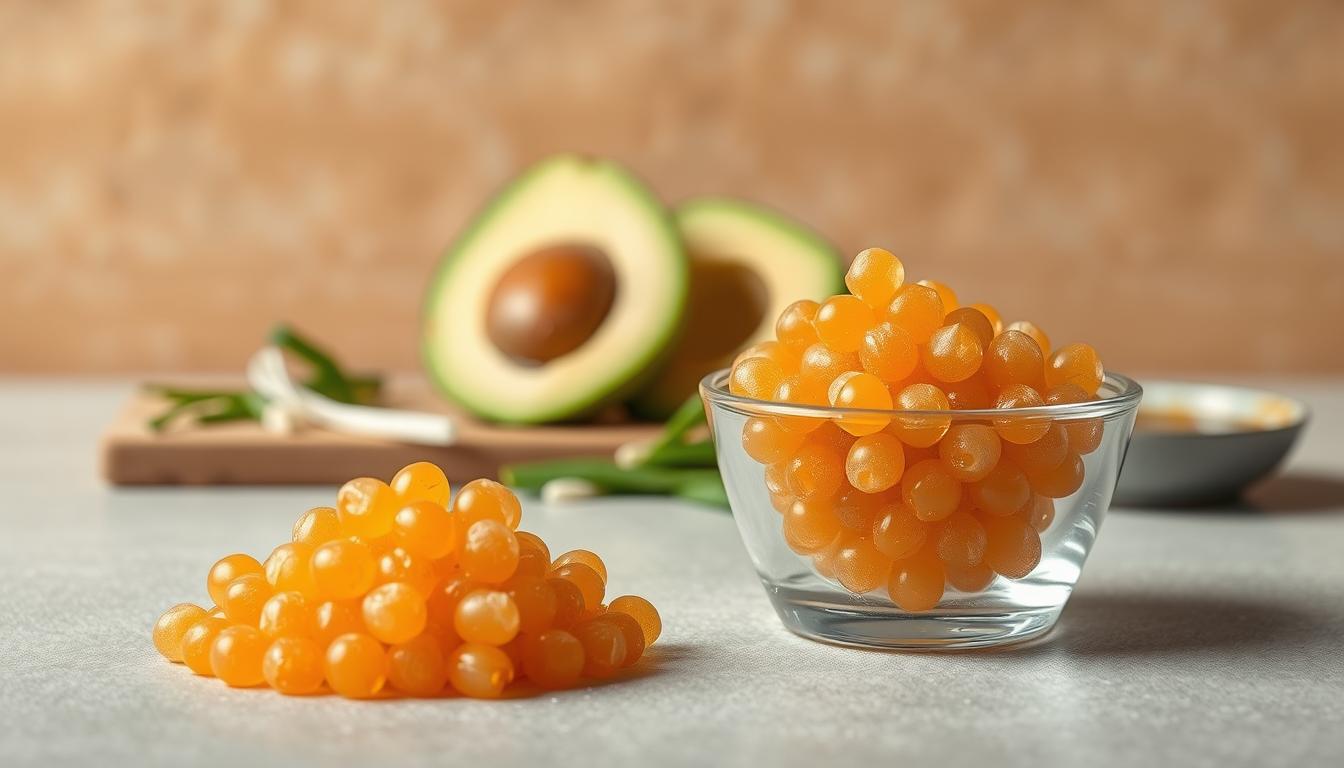Masago is a type of fish roe found in Japanese cuisine. It’s packed with protein, omega-3 fatty acids, and minerals. This makes it a nutritious choice for a healthy diet.
Knowing what masago is and its nutritional value opens up its health benefits. It’s a delicacy in many dishes, especially sushi. Let’s explore masago’s benefits, nutritional profile, and health advantages.
Looking into masago’s benefits and nutrition helps us see how to add it to our meals. Its nutritional value and versatility in dishes make it appealing.
Key Takeaways
- Masago is a type of fish roe rich in protein and omega-3 fatty acids
- It offers numerous health benefits, including masago benefits and health benefits of masago
- Masago nutrition is an essential aspect of its appeal
- It is a popular ingredient in Japanese cuisine, particularly in sushi
- Incorporating masago into your diet can have numerous health benefits
- Masago is a nutritious and healthy food option, making it an excellent choice for those looking to improve their diet
What is Masago and Its Origins
Masago, also known as capelin roe, comes from the capelin fish. This small, oily fish lives in the North Atlantic and Pacific oceans. For centuries, it has been a part of Japanese cuisine. It’s used as a garnish or mixed with other ingredients to make various dishes.
Masago is packed with masago health benefits. It’s full of protein, omega-3 fatty acids, and minerals. This makes it a nutritious choice for a healthy diet.
In Japanese cuisine, masago adds flavor and texture to dishes like sushi and sashimi. It’s also a topping for rice bowls and salads. The masago health properties make it great for those wanting to eat more nutritious foods. Plus, it’s a good source of masago vitamins, including vitamin D and B12.
Some key traits of masago include:
- Small, delicate eggs with a sweet and nuanced flavor
- Rich in nutrients, including protein, omega-3 fatty acids, and minerals
- Often used as a garnish or mixed with other ingredients in Japanese cuisine
Masago is unique because it’s smaller and more delicate than other fish roe. It has a sweeter flavor and is rich in nutrients. This makes it a fantastic choice for adding health benefits to various dishes, from sushi to salads.
The Nutritional Profile of Masago
Masago is packed with nutrients that offer many health benefits. It’s a great source of protein, which helps build and repair body tissues. It also has omega-3 fatty acids, important for heart health and brain function.
Masago is also rich in minerals like calcium, iron, and potassium. These minerals are key for strong bones, preventing anemia, and controlling blood pressure. With its low calorie count and high antioxidants, masago is a nutritious choice for better health.
Some of the key benefits of masago include:
- High protein content for building and repairing tissues
- Rich in masago omega-3 benefits for heart health and brain function
- Good source of masago minerals, such as calcium, iron, and potassium
- Low in calories and rich in antioxidants
In summary, masago is a nutritious food that offers many health benefits. Its high nutrient content, omega-3 benefits, and minerals make it a great addition to a healthy diet.
Understanding Masago’s Role in Sushi
Masago is a key ingredient in sushi, known for its bright colors and light taste. It’s packed with health benefits and nutrition, making it a fantastic addition to many sushi dishes. Masago is often used as a garnish or mixed with other ingredients to create tasty rolls.
The color of masago in sushi can change, each color having its own meaning and use. For instance, orange masago adds a burst of flavor and color to rolls. On the other hand, green masago brings a subtle flavor and texture. Knowing about these colors can enhance your appreciation for sushi-making and the health perks of masago.
Common Sushi Preparations
- Sushi rolls with masago and rice
- Sashimi with masago and soy sauce
- Nigiri with masago and wasabi
Color Variations and Their Meanings
Masago comes in different colors, from orange to green, each with its own significance in sushi. By grasping the meanings behind these colors, you can better appreciate the art of sushi-making. You’ll also understand the health benefits and nutritional value of masago.
Essential Masago Benefits for Health and Wellness
Masago is a nutritious food that’s good for your health. It has health benefits of masago that make it great for a healthy diet. It helps your heart, reduces inflammation, and boosts brain function. Plus, it’s low in calories and packed with antioxidants, perfect for weight loss or better health.
The masago benefits include lots of protein, omega-3 fatty acids, and minerals. These nutrients help your heart and reduce inflammation. Many ask is masago good for you, and the answer is yes, thanks to its many health benefits of masago.
It’s also low in calories and full of antioxidants, ideal for weight loss or better health. Some might wonder is masago spicy, but it depends on how it’s prepared. Overall, masago benefits make it a fantastic choice for a healthy diet.

The health benefits of masago are many, making it a great addition to various dishes. With its protein, omega-3s, and minerals, masago health properties are excellent for improving health and wellness.
Omega-3 Content and Heart Health Properties
Masago is known for its high omega-3 fatty acids. These are key for heart health and brain function. Eating masago can improve your heart health and lower inflammation. It also boosts brain function and reduces the risk of chronic diseases.
The minerals in masago add to its health benefits. Some of the main advantages include:
- Improved heart health due to its omega-3 content
- Enhanced brain function and cognitive development
- Reduced inflammation and risk of chronic diseases
Studies show masago’s anti-inflammatory effects are great for heart disease and cancer prevention. Its omega-3 and minerals make it a healthy choice. Knowing the benefits of masago helps you choose it for your meals.
In summary, masago’s omega-3 and minerals are great for a healthy diet. It helps improve overall health and lowers disease risk.
Masago’s Protein and Mineral Content
Masago is packed with nutrients like protein, omega-3 fatty acids, and minerals. It’s great for building and repairing body tissues. This makes it a top choice for those wanting to boost their health.
Masago also has important minerals like calcium, iron, and zinc. These are key for keeping bones strong, blood healthy, and the immune system strong. They’re vital for our overall health.
Some of the key masago nutrients and their benefits include:
- Protein: builds and repairs tissues
- Omega-3 fatty acids: supports heart health
- Calcium: essential for strong bones
- Iron: vital for healthy red blood cells
- Zinc: supports immune function

Masago is a nutritious food that offers many essential nutrients. It’s a fantastic addition to a healthy diet. Its health benefits and nutrition make it a great choice for supporting overall well-being.
Safety Considerations and Potential Allergies
When looking at the masago health benefits, it’s key to know the risks. Masago is a nutritious food, but it can pose some dangers. People allergic to fish or shellfish should be careful with masago, as it can trigger allergic reactions.
The benefits of eating masago are many, but safety is paramount. Masago must be stored and handled correctly to avoid spoilage. Also, masago can be spicy, which might be a problem for some. Start with small amounts to avoid any issues.
- Avoiding masago if you have a known fish or shellfish allergy
- Storing masago in a cool, dry place to prevent spoilage
- Handling masago safely to prevent cross-contamination
Knowing these safety tips helps you enjoy the masago health benefits safely. It makes sure your dining experience is both safe and enjoyable.
Incorporating Masago into Your Diet
Masago, a type of capelin roe, is packed with health benefits. It’s high in protein and omega-3s. To enjoy these benefits, add masago to your meals in a way that fits your life.
Masago’s nutrition is full of vitamins and minerals. It’s great for many dishes. Here are some ideas to use masago:
- Sushi rolls with masago and cucumber for a refreshing twist
- Masago-topped salads with mixed greens and citrus vinaigrette
- Stir-fries with masago, vegetables, and your choice of protein
For serving sizes, aim for 1-2 tablespoons per serving. This way, you get the most from masago’s nutrition. Masago adds flavor and health benefits to any meal.
Sustainability and Environmental Impact
Thinking about the masago health benefits and masago nutrition means also considering its impact on the environment. Masago is a wild-caught fish roe, taken from the ocean. Its production can harm the environment. But, many producers are now using sustainable fishing methods, which is a good sign.
The benefits of eating masago are many. Choosing a sustainable masago product makes you feel good about your choice. Here are some things to look for in sustainable masago:
- Wild-caught vs. farmed masago
- Sustainable fishing practices
- Environmental certifications
- Transparent production processes
By picking sustainable masago, you help lessen the environmental harm of its fishing and production. You still get to enjoy the masago health benefits and
It’s also key to know what is masago and what is masago in sushi. Masago is a fish roe used in sushi and Japanese dishes. It has a nutty taste and crunchy texture, adding flavor and beauty to food.
Conclusion: Making Masago Part of Your Healthy Lifestyle
Incorporating masago into your diet is a great way to boost your health. This fish roe is full of protein, omega-3 fatty acids, and important minerals. It’s a tasty and healthy choice for any meal.
Adding masago to your diet can help your heart and brain health. It also has anti-inflammatory properties. Plus, it’s low in calories and can make any dish healthier.
Try making masago a staple in your healthy eating habits. Explore new recipes and enjoy its vibrant colors and textures. Your body and taste buds will appreciate it.
